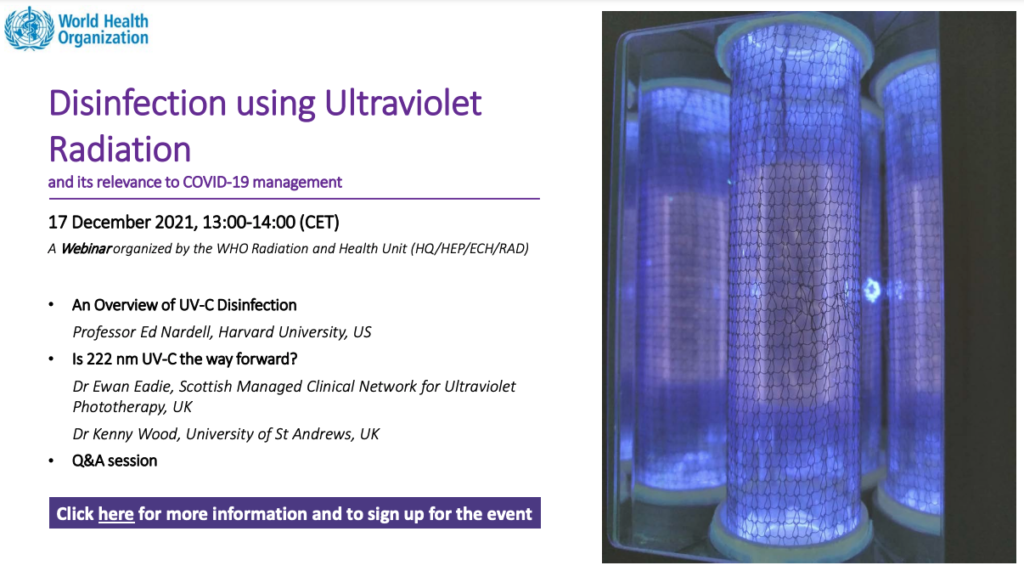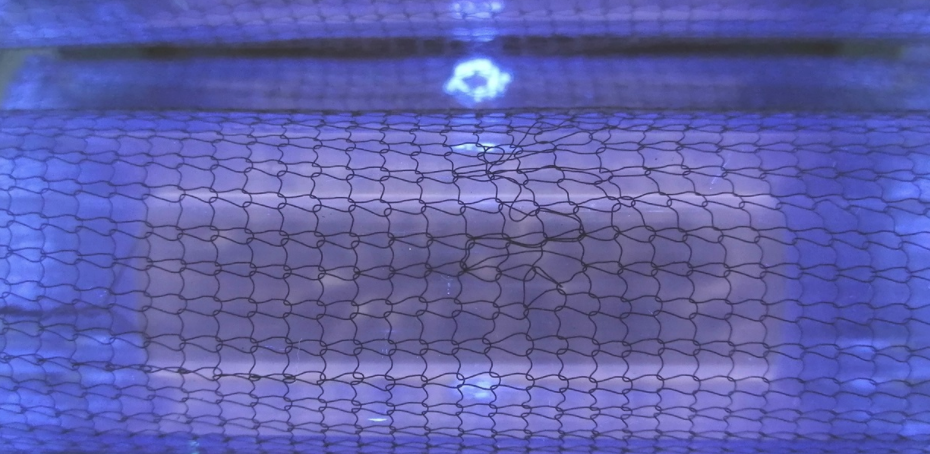Background
The ability of ultraviolet radiation to disinfect water, surfaces and air has been known for over a hundred years. In the last few decades, the primary application across the world has been water disinfection, but it has also matured as a means of disinfection in healthcare and other environments. The COVID-19 pandemic has highlighted the potential for UV radiation to manage the transmission of the disease, both using well-developed technologies and emerging technologies.
Dr Ed Nardell will provide an overview of the application of UV for disinfection for a range of pathogens and environments. Dr Ewan Eadie and Dr Kenny Wood will describe their research on the application of 222 nm UV excimer lamps for area disinfection.
Provisional agenda
Moderator: John O’Hagan
13:00 – 13:05: Welcome address – Dr E. van Deventer, WHO
13:05 – 13:25 – An Overview of UV-C Disinfection – Professor Ed Nardell, Harvard University, USA
13:30 – 13:50 – Is 222 nm UV-C the way forward? Dr Ewan Eadie, Scottish Managed Clinical Network for Ultraviolet Phototherapy, UK; Dr Kenny Wood, University of St Andrews, UK
13:50 – 14:00 – Q&A session
Registration
Please follow the link to register by Thursday 16 December 16:00 CET:
https://who.zoom.us/webinar/register/WN_gsM4fuKQRtShaEeBMon2xw
Upon registration, you will receive an email with Webinar connection details.

Speakers
Dr Ed Nardell
Dr Ed Nardell is a professor of medicine (global health) and public health (environmental health, immunology and infectious diseases) at Harvard University. His research interest evolved from tuberculosis control to include airborne transmission and its control through administrative and environmental interventions. He had the privilege of collaborating with Richard Riley, who with William Firth Wells, were early pioneers in airborne transmission and the application of germicidal UV air disinfection. In 2005 he led the development of the Airborne Infection Research (AIR) Facility near Pretoria, South Africa. Modelled after the Wells-Riley experimental ward in Baltimore in the 1960s, it employed human-to-guinea pig transmission to test the real-world impact on transmission of germicidal UV, masks on patients, inhaled antibiotics, and prompt effective treatment. Through a Fogarty grant he further developed evidence-based guidelines and generated safety data on the application of germicidal UV. Currently, he is engaged with collaborators in converting the AIR Facility into a human-to-hamster SARS-CoV-2 transmission apparatus for testing germicidal UV and other transmission interventions.
Dr Ewan Eadie
Dr Ewan Eadie is Head of Scientific Services at the Photobiology Unit and lead clinician for the Scottish Managed Clinical Network for Ultraviolet Phototherapy. He has extensive photophysics experience and an international reputation in the field of medically applied photophysics. Dr Eadie’s current area of research interest is in dosimetry and accurate metrology of optical radiation sources and the impact on healthcare and public health. This includes ultraviolet, visible, and infrared radiation in environmental, healthcare, and cosmetic settings. With improved dosimetry comes a greater understanding of the interaction between optical radiation and tissue. This allows for improved treatment and diagnosis in areas of healthcare that utilize such optical radiation sources.
Dr Kenny Wood
Dr Kenny Wood has been a lecturer in the School of Physics & Astronomy at the University of St Andrews since 2001. His twin research areas of astronomy and medical physics make use of three-dimensional Monte Carlo radiation transfer techniques that he has developed since the mid-1990s. Since 2005 he has worked with colleagues in the Photobiology Unit at Ninewells Hospital on theoretical and experimental studies of the penetration of optical and ultraviolet light into human skin with applications to various phototherapy treatments for skin and brain cancer. His most recent research is studying far-UVC light for inactivating and preventing the airborne spread of viruses, considering its safety (UVC light-skin interactions) and efficacy (whole room CFD+UVC simulations and bioaerosol chamber experiments).
